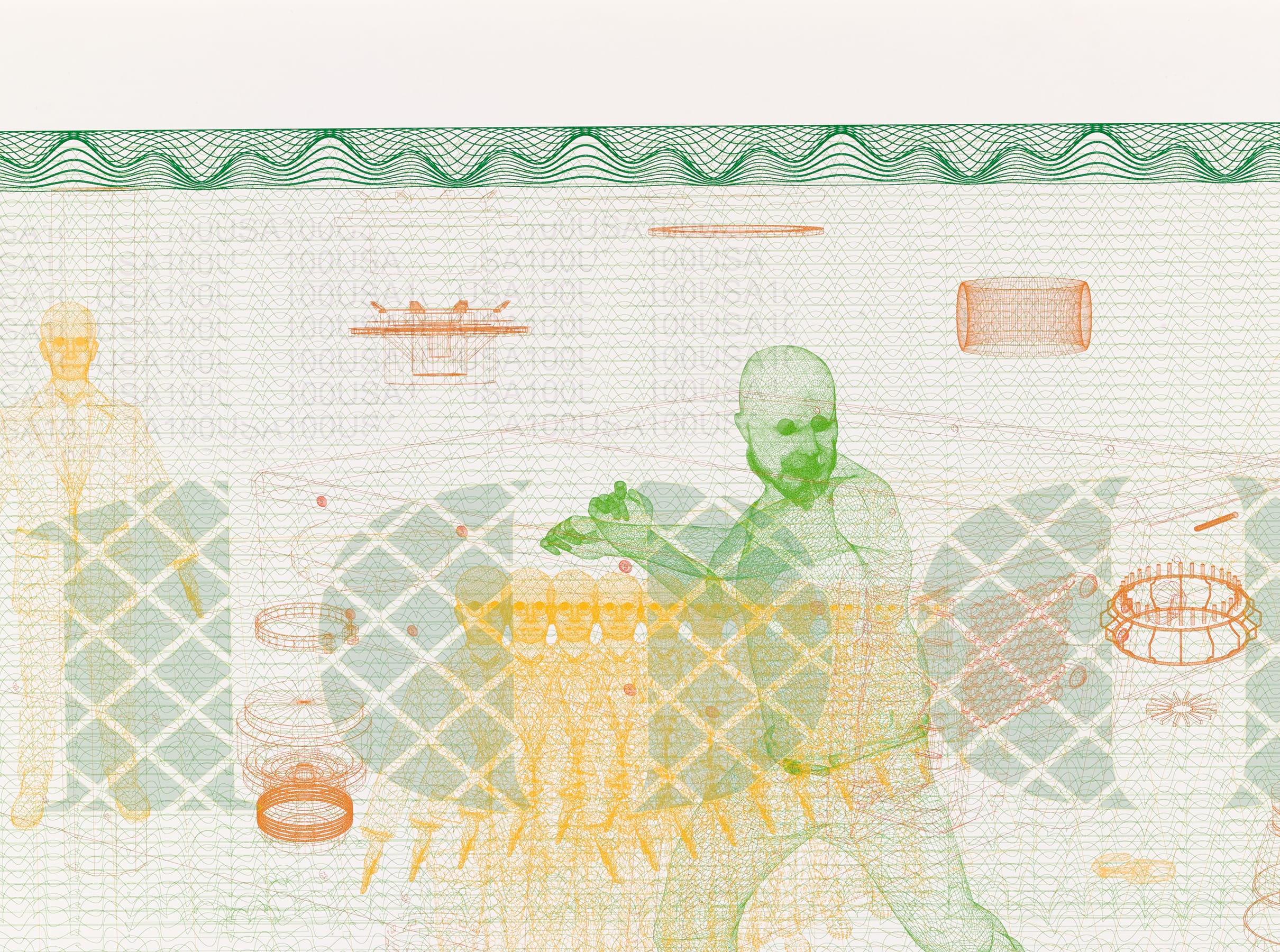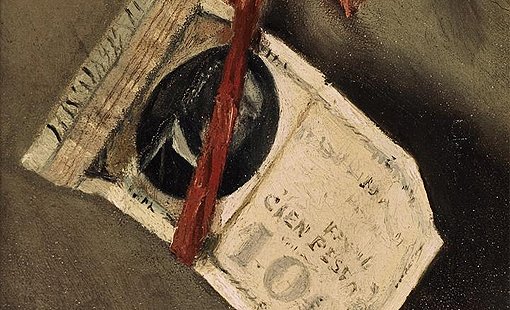
The euro as a canvas: European Central Bank contest to redesign banknotes
The banknote as a cultural symbol
As well as their obvious financial function, banknotes have historically served as vectors of ideological, cultural and political expression. The designs on the notes convey certain values, celebrate shared public achievements and reinforce identity narratives. In many cases, they are small hand-circulated works of art, bearing messages – sometimes subtle, sometimes more explicit – about those objects our society considers worthy of remembering and extolling. Every banknote can thus be viewed as a silent but powerful instrument of communication.
Today, we have a rare opportunity to take part in the design of a new series of euro banknotes and in this way contribute to creating an artistic and cultural symbol that will be shared by millions of Europeans.
Banknotes in the Banco de España Collection
Whether it is as an object, a motif or a theme, banknotes play a central role in many of the works in the Banco de España's collection. They are depicted in pieces from our historical collection, such as the 1898 painting One Hundred Peseta Note attributed to Mariano Fortuny y Madrazo, which is a sort of vanitas, distilling the notion of the brevity of life and wealth into the primary symbol of commercial exchange: money. Another example can be found in Sevillian painter José Villegas y Cordero's symbolist studies for banknote designs, drawn in the early twentieth-century.
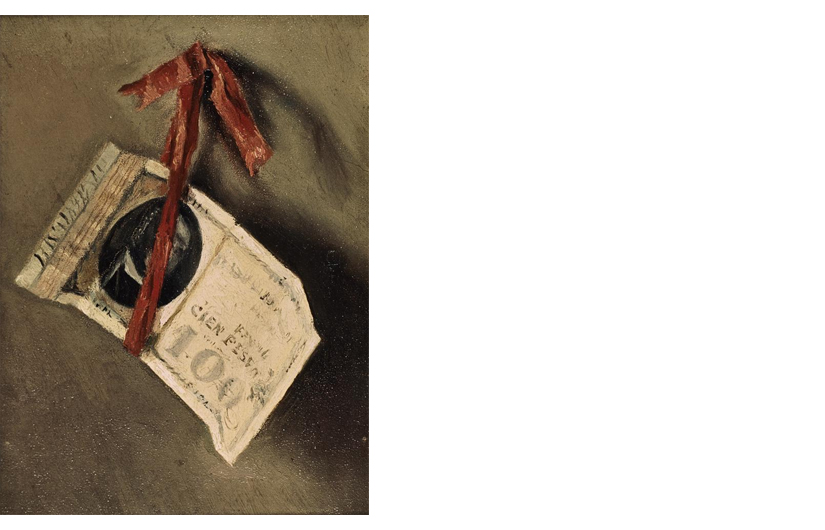 Mariano Fortuny y Madrazo (attributed): One-Hundred Peseta Note (ca. 1898)
Mariano Fortuny y Madrazo (attributed): One-Hundred Peseta Note (ca. 1898)
Other distinctly conceptual works recently acquired by the collection also reference banknotes. These include Capital. Merchandise. Guilloche (2015) and Period_Fake (2020) by Daniel García Andújar, which address a variety of issues related to the idea of paper money as an artistic medium, and Carlos Aires' sculpture Reflections in a Golden Eye (2018), with its menacing honeycomb of (mostly male) eyes taken from figures on real banknotes circulating in some of the richest countries in the world, printed on golden stainless steel plates. Other highlights include José Luiz Moraza's series International Bank of Work Time (2020), which explores the relationship between time and money, and the photocollage Branding (2016), by Francesc Ruiz, made using the faces that appeared in the penultimate pre-euro issue of banknotes, designed by Cuenca artist José María Cruz y Novillo.
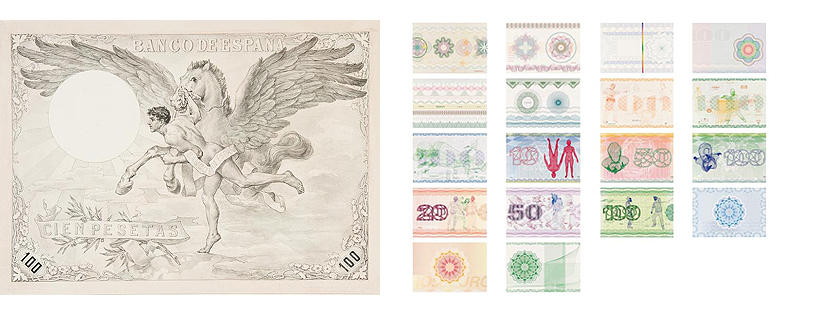 José Villegas y Cordero (attributed): Hippogriff in Flight (ca. 1903) | Daniel García Andújar: Capital. Merchandise. Guilloche (2015)
José Villegas y Cordero (attributed): Hippogriff in Flight (ca. 1903) | Daniel García Andújar: Capital. Merchandise. Guilloche (2015)
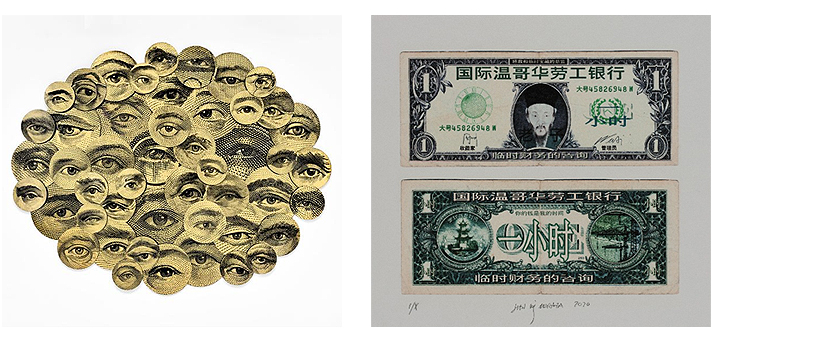 Carlos Aires: Reflections in a Golden Eye (2018) | Juan Luis Moraza: International Bank of Work. 1 hour (2020)
Carlos Aires: Reflections in a Golden Eye (2018) | Juan Luis Moraza: International Bank of Work. 1 hour (2020)
And of course there is Ignasi Aballí's installation Euro Zone (2009), which highlights the arbitrary and fluctuating way in which economic value is created using signs cut out and placed in rows, like flags, each bearing a different figure. The piece is located in a transit area in the Banco de España building on Plaza Cibeles, which the artist, in collaboration with architecture firm Paredes Pedrosa, has turned into an unusual exhibition space.
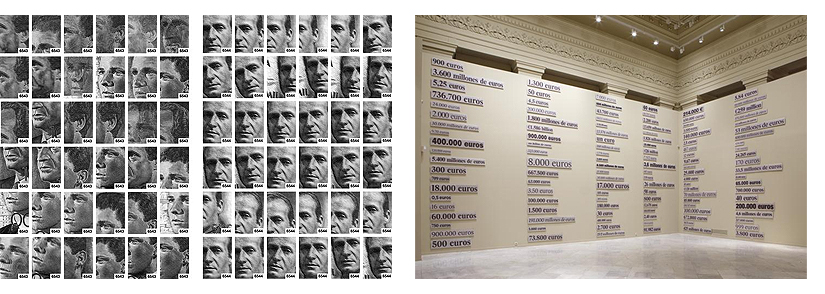 Francesc Ruiz: Branding (2016) | Ignasi Aballí: Euro Zone (2009)
Francesc Ruiz: Branding (2016) | Ignasi Aballí: Euro Zone (2009)
The start of the creative process
The ECB's Eurosystem has launched a redesign of its euro banknotes. The process takes place regularly every 10 to 15 years and is intended to improve security and guard against forgery. The process was launched in 2021 with the aim of creating banknotes that are more secure, inclusive and representative of European identity and values.
The first step was to define two essential features: the theme and the motifs. The theme is the central idea guiding the visual narrative of the banknote. For example, the current theme of euro banknotes is ‘ages and styles’, with each designation representing a stage in European architectural history. The motifs are the specific graphic features used to express this theme. Doorways, windows and bridges on the current notes symbolise openness and cooperation between the peoples of Europe and with the rest of the world.
New themes and motifs
In November 2023, the Governing Council of the ECB selected two themes with their respective motifs![]() :
:
- European culture. Europe’s rich cultural heritage and dynamic cultural and creative sectors strengthen our European identity, forging a shared sense of belonging. Culture promotes common values, inclusion and dialogue in Europe. The motifs for this theme depict various cultural activities and spaces, as well as iconic personalities, including Miguel de Cervantes.
- Rivers and Birds. Rivers and birds know no borders, symbolising freedom and unity and our connection to nature. This theme celebrates the diversity of European ecosystems and reminds us of our responsibility to protect the environment. The motifs on the reverse represent European institutions and the values of the common project.
The two themes seek to make citizens feel represented and establish a link to the banknotes as a tangible symbol of European unity.
The design selection process
Selection of the specific designs began on 15 July. The designs have to respect certain parameters such as distinctive colours for each denomination, the numerical and textual value with a clear typeface, security elements and tactile symbols for the visually impaired.
Pan-European design competition
The European Central Bank has announced the launch of a design contest, open to all graphic designers residing in the European Union. The winning design might be Spanish!
You can view the contest rules here: link![]() .
.
The competition will be held in two phases:
- First phase: Applications can be submitted up to 12:00 noon CET on 18 August 2025. The ECB will review the applications, taking into account the designer's training, experience and creative background, so it is important to complete this information carefully (supporting documentation will be requested at a later stage). Designers should say whether they are submitting proposals for ‘European Culture’, ‘Rivers and Birds’ or both. Up to 20 designers will be selected for each theme.
- Second phase: The shortlisted designers will be invited to submit their design proposals. The designs will all be anonymised before being assessed by the jury, a panel of independent experts. The competition will conclude with a report including up to five designs per theme.
The Governing Council will then decide which designs are to be submitted to a public survey to gather people's preferences and decide on the final design.
